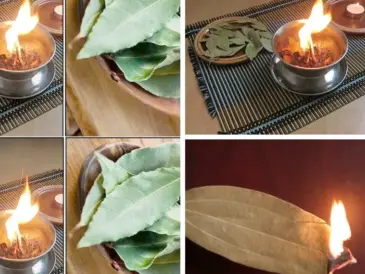When most people think of bay leaves, they picture a fragrant herb used to flavor soups and stews – not something you’d scatter across your garden beds. But this humble kitchen spice has some surprising powers beyond the pantry.
For centuries, bay leaves (Laurus nobilis) have been valued not only for their aroma and flavor but also for their natural pest-repelling, soil-enhancing, and healing properties.
1. Bay Leaves Repel Pests Naturally
Bay leaves are one of nature’s most effective non-toxic pest repellents. They contain powerful essential oils – particularly eucalyptol (cineole), linalool, and eugenol – that release a scent insects can’t stand.
Repels a wide range of garden invaders:
- Aphids
- Ants
- Beetles
- Moths
- Weevils
- Cockroaches
- Caterpillars
When scattered around your garden or crushed and sprinkled near plants, bay leaves help create a scent barrier that keeps insects from feeding on delicate foliage or nesting in the soil.
You can also tuck a few dried bay leaves:
- In your potting soil to deter fungus gnats.
- Around compost bins to discourage flies.
- Beneath mulch or raised beds to ward off ants and other ground-dwelling insects.
Tip:
Crush the leaves slightly before using them – this releases the aromatic oils and enhances their repelling power. Replace them every few weeks or after heavy rain.
Unlike chemical sprays, bay leaves are completely safe for bees, butterflies, pets, and children – making them a perfect eco-friendly pest control solution.
2. Keeps Snails and Slugs Away
If you’ve battled slimy snails and slugs chewing through your lettuce and seedlings, bay leaves can come to your rescue.
These soft-bodied pests are sensitive to strong aromatic compounds and avoid surfaces that contain plant-based oils like those in bay leaves.
How to use them effectively:
- Scatter whole dried leaves in a circle around vulnerable plants like lettuce, cabbage, or hostas.
- Place crushed leaves at the base of containers and raised beds where slugs climb up.
- Mix dried bay leaf powder into your mulch layer to create a protective scent barrier.
Because the leaves break down slowly, they act as a long-lasting deterrent without harming the soil or beneficial organisms.
Bonus: You can combine bay leaves with coffee grounds or crushed eggshells for a multi-layered natural defense against slugs and snails.
3. Improves Soil Health When Decomposed
Bay leaves aren’t just good for pest control – they also add value to your soil once they break down.
Although the leaves are thick and take time to decompose, they’re rich in calcium, iron, and magnesium, all of which benefit plant health.
When added to compost or used as part of a natural mulch layer, bay leaves:
- Enrich the soil with trace minerals.
- Support microbial activity that aids in nutrient cycling.
- Improve soil structure and moisture retention.
How to use bay leaves for soil enrichment:
- Shred dried bay leaves or crush them into smaller pieces.
- Mix into the top few inches of soil or compost pile.
- Water lightly to activate decomposition.
Over time, they’ll release nutrients slowly – acting like a mild organic fertilizer.
And unlike certain tough evergreen leaves, bay leaves don’t acidify the soil significantly, making them safe for most garden plants.
4. Naturally Deters Rodents and Garden Critters
If you’ve ever found half-eaten tomatoes or nibbled seedlings, you know how frustrating rodents and small animals can be.
The strong scent of bay leaves deters mice, rats, and even squirrels, which dislike the oils released from crushed leaves.
How to use:
- Scatter crushed bay leaves around garden borders, sheds, and compost bins.
- Place a few inside small mesh bags or cheesecloth sachets, and hang them near stored seeds or tools.
- Refresh every 2–3 weeks for lasting effect.
This simple, chemical-free trick helps keep rodents away from garden produce and storage areas – without the need for harmful traps or poisons.
Tip: Combine bay leaves with mint or cloves for an even stronger repelling blend.
5. Reduces Mold and Fungal Growth
Because of its natural antifungal and antibacterial compounds, bay leaf can help keep fungal spores, mildew, and mold from taking hold in humid garden environments.
The same properties that make bay leaf useful for preserving food also inhibit fungal pathogens in the soil and on plant surfaces.
Practical ways to use bay leaves for this:
- Mix crushed dried leaves into potting soil before planting to reduce fungal contamination.
- Scatter leaves in greenhouses, storage areas, or tool sheds to absorb moisture and prevent moldy odors.
- Steep bay leaves in boiling water, let it cool, and use the infused water as a gentle natural spray on plants prone to mildew (like cucumbers and zucchinis).
While not as powerful as specialized fungicides, bay leaves offer a safe, preventive layer against early-stage fungal problems – especially in damp or poorly ventilated areas.
6. Attracts Pollinators and Beneficial Insects
An unexpected but wonderful benefit of scattering bay leaves is that while they repel pests, they don’t deter beneficial insects – and may even help attract them.
As the leaves slowly release their subtle aroma into the air, they create a more balanced ecosystem in your garden.
Pollinators like bees, hoverflies, and butterflies are drawn to this natural scent environment, especially when combined with other herbs such as rosemary, thyme, and lavender.
This makes bay leaves an excellent addition around:
- Flower beds
- Vegetable gardens
- Herb borders
- Fruit-bearing plants
By supporting pollinators while keeping harmful insects at bay, bay leaves help maintain natural garden harmony – the way nature intended.
How to Scatter Bay Leaves in the Garden – Step by Step
If you’re new to using bay leaves outdoors, here’s a simple way to get started:
1. Choose the right type of leaves
Use dried or semi-dried bay leaves (from Laurus nobilis, not ornamental bay species). You can also use leftover kitchen bay leaves – just make sure they’re not seasoned with salt or oil.
2. Crush or tear the leaves
Breaking them releases the essential oils that make them effective. You don’t need to powder them – just crumble them gently in your hands.
3. Decide where to apply
- Around the base of plants prone to pest attacks.
- Inside pots or planters to deter gnats.
- Along garden edges to block crawling insects.
- In compost bins to minimize odor and flies.
4. Replace regularly
Bay leaves lose potency over time, especially after rain or irrigation. Replace or refresh them every 2–4 weeks for continuous protection.
5. Add to compost afterward
Once the scent fades, collect the used leaves and toss them into your compost pile. They’ll break down slowly, enriching your soil further.
DIY Bay Leaf Garden Sprays and Powders
If you want to get creative, you can turn bay leaves into simple homemade garden treatments:
1. Bay Leaf Insect Spray
A gentle, all-purpose repellent for aphids, flies, and ants.
Ingredients:
- 10–15 dried bay leaves
- 2 cups of boiling water
- 1 teaspoon mild dish soap (optional)
Instructions:
- Boil water and pour over the leaves.
- Let steep for 24 hours, then strain.
- Add dish soap for extra stickiness.
- Pour into a spray bottle and apply to leaves and soil.
Repeat every 7–10 days or after heavy rain.
2. Bay Leaf Powder for Soil and Mulch
Crushed bay leaf powder adds nutrients while deterring crawling pests.
How to make:
- Grind dried bay leaves in a food processor or mortar and pestle.
- Sprinkle lightly over the topsoil or mix into mulch.
- Water gently to activate aroma and nutrient release.
Complementary Herbs to Combine With Bay Leaves
For maximum natural pest control and aroma, pair bay leaves with other aromatic herbs. Together, they create a synergistic defense that smells wonderful and keeps your garden thriving.
Best herbs to mix:
- Rosemary – repels beetles, mosquitoes, and cabbage moths.
- Sage – deters carrot flies and snails.
- Lavender – attracts pollinators and calms the air.
- Mint – repels ants and rodents.
- Thyme – keeps aphids and whiteflies away.
Scatter a mix of crushed herbs around your plants to create a natural pest-repelling mulch with added aromatherapy for your garden.
Why Bay Leaf Is an Eco-Friendly Alternative
As more gardeners move away from chemical pesticides, bay leaves offer a gentle, biodegradable, and sustainable option.
Unlike synthetic repellents, which can kill beneficial insects or contaminate soil, bay leaves:
- Leave no toxic residues.
- Biodegrade naturally over time.
- Support soil microbes and pollinators.
- Are completely safe for pets and wildlife.
You can even grow your own bay laurel tree and harvest leaves directly – ensuring a fresh, renewable supply for both your kitchen and your garden.
Common Questions About Using Bay Leaves in the Garden
Can bay leaves harm plants?
No – bay leaves are completely safe for plants. They’re non-toxic and won’t alter soil pH significantly.
Do fresh or dried leaves work better?
Dried leaves are usually stronger because they concentrate the essential oils. Fresh leaves work too but tend to break down faster.
Can I compost bay leaves?
Yes, but shred them first. Whole bay leaves decompose slowly due to their thick, waxy texture.
Will bay leaves attract animals?
No. In fact, the aroma tends to repel rodents and other small pests rather than attract them.
Sometimes, the best garden helpers aren’t new inventions – they’re old traditions rediscovered.
Scattering bay leaves in your garden is one of those timeless secrets that combine ancient wisdom with modern sustainability.




